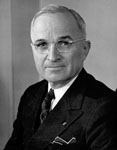Making Deviation Standard
 Resources for this lesson:
Resources for this lesson:
![]() Key Terms
Key Terms
Mean Absolute Deviation
> Glossary ![]()
> Calculator Resources ![]()
> Teacher Resources: Instructional Notes ![]()
 The 22nd Amendment to the Constitution limits the presidential length of service to two terms. This amendment was passed in 1947, during President Harry Truman’s term.
The 22nd Amendment to the Constitution limits the presidential length of service to two terms. This amendment was passed in 1947, during President Harry Truman’s term.
Here is another situation related to U.S. presidents.
Andrew finds it very interesting that the average length of a president’s service is 5.071 years, while the length of a presidential term is four years. If the 22nd Amendment allows two terms, Andrew figures a president would either serve one full term of 4 years, or two full terms of 8 years. This averages to 6 years.
What accounts for the average length of the presidential service not being the 6 years, as Andrew calculates?
The answer lies in the distribution of the data. For various reasons (i.e., illness, impeachment, death), many of the presidents did not serve whole terms.
- Scroll through the data and observe how many presidents served less than four years, or more than eight years.
- Observe how many presidents served exactly one or two full terms (that is, exactly four or eight years).
As you look through the data, do you notice how the number of years the presidents have served has varied greatly? Statisticians and mathematicians can use Mean Absolute Deviation to describe this distribution.
 You learned about the mean absolute deviation in previous mathematics courses.The next activity will help you to remember how to calculate the Mean Absolute Deviation of a data set.
You learned about the mean absolute deviation in previous mathematics courses.The next activity will help you to remember how to calculate the Mean Absolute Deviation of a data set.
President Harry Truman








